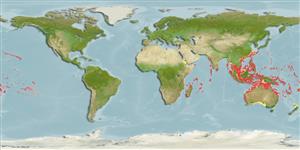Classification / Names
Common names from other countries
Main reference
Size / Weight / Age
Max length : 270 cm TL male/unsexed; (Ref. 5213); common length : 190 cm TL male/unsexed; (Ref. 5450); max. published weight: 400.0 kg (Ref. 26367)
Length at first maturity
Lm ?, range 129 - ? cm
Environment
Marine; brackish; reef-associated; depth range 1 - 200 m (Ref. 89972), usually ? - 50 m (Ref. 37816)
Climate / Range
Tropical, preferred ?; 29°N - 39°S, 24°E - 122°W (Ref. 5222)
Distribution
Indo-Pacific: Red Sea to Algoa Bay, South Africa and eastward to the Hawaiian and Pitcairn islands, north to southern Japan, south to Australia. Absence in the Persian Gulf is puzzling.
Countries | FAO areas | Ecosystems | Occurrences | Introductions
Short description
Dorsal
spines
(total): 11;
Dorsal
soft rays
(total): 14-16;
Anal
spines: 3;
Anal
soft rays: 8. Dorsal fin spines of large individuals increase in size from front to back. It is the largest of all coral reef dwelling bony fishes (Ref. 37816); overall dark grey color with variable amount of pale spots/blotches; cycloid scales on body; body with auxiliary scales; greatest depth of body 2.3-3.4 in SL; short pelvic fins, 23.0-2.7 in head length (Ref. 90102); further characterized by having head length 2.2-2.7 times in SL; interorbital width 3.3-6.2 times in HL; flat to slightly convex interorbital area, convex dorsal head profile; subangular preopercle, finely serrate, the angle rounded; convex upper edge of operculum; eye diameter 5.8-14 in head length; subequal anterior and posterior nostrils; maxilla reaching past vertical at rear edge of eye; 2-3 rows of teeth on midlateral part of lower jaw increasing to 15-16 rows in fish of 177 cm SL; small or absent canine teeth at front of jaws (Ref. 89707).
IUCN Red List Status (Ref. 115185)
Threat to humans
Traumatogenic (Ref. 4690)
Human uses
Fisheries: subsistence fisheries; aquaculture: commercial; gamefish: yes; aquarium: commercial
More information
ReferencesAquacultureAquaculture profileStrainsGeneticsAllele frequenciesHeritabilityDiseasesProcessingMass conversion
Tools
Special reports
Download XML
Internet sources
Estimates of some properties based on models
Phylogenetic diversity index
PD50 = 0.5000 many relatives (e.g. carps) 0.5 - 2.0 few relatives (e.g. lungfishes)
Trophic Level
4.0 ±0.60 se; Based on food items.
Resilience
Very Low, minimum population doubling time more than 14 years (Preliminary K or Fecundity.)
Vulnerability
Very high vulnerability (86 of 100)
Price category
